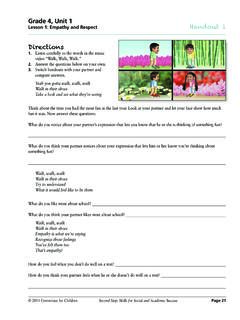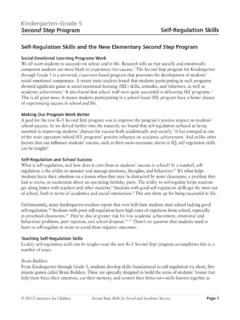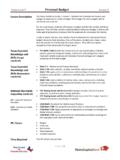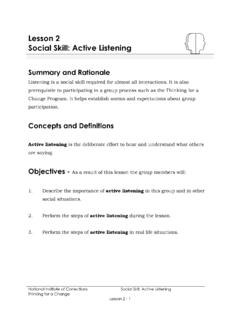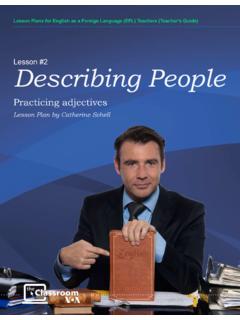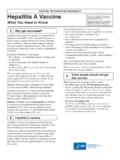Transcription of Grade 2, Unit 1 Lesson 1: Being Respectful Home Link
1 Home Link 2011 Committee for Children Second Step: Skills for Social and Academic Success Page 13(CHILD S NAME)(DATE)(ADULT S SIGNATURE) Grade 2, unit 1 Lesson 1: Being RespectfulWhat Is My Child Learning? Your child is learning how to be Respectful at Is It Important? Being Respectful helps children be better learners. Ask your child: How do you behave respectfully at school?Read TogetherThere are many ways to be Respectful at school. You can: Be kind and polite Take turns Pay attention and listen to the speaker Raise your hand to speakWhen you re Being Respectful , you re thinking about how others want to be treated and treating them that way. Thinking about how you would like to be treated will help you decide how to treat Together: Record of Respect1. Discuss with your child ways he or she showed you or others respect Write examples of the Respectful behavior If you want, you can use the back of this paper to add I showed respect by: Home Link 2011 Committee for Children Second Step: Skills for Social and Academic Success Page 19(CHILD S NAME)(DATE)(ADULT S SIGNATURE) Lesson 3: Using Self-TalkGrade 2, unit 1 What Is My Child Learning?
2 Your child is learning and practicing four Skills for Learning: focusing attention, listening, using self-talk, and Being Is It Important?Using Skills for Learning helps children be better learners. Self-talk helps children stay focused and on task. Ask your child: When do you use self-talk to help you be a better learner at school?Read TogetherUsing Skills for Learning helps you be a better learner. You ve been learning to focus your attention, listen, and use self-talk. Focusing your attention and listening show week, you practiced self-talk. Self-talk is talking to yourself in a quiet voice or in your head. Using self-talk helps you stay focused and on task and manage Together: Distraction Detectives1. Go to the room where your child usually does his or her homework and pretend you re both second- Grade students working on a homework Become distraction detectives! Walk around the room and identify things that could distract you (such as television, computer, toys, or siblings).
3 3. For each distraction, decide on self-talk you could use to stay focused and on Say your self-talk out loud and write it down below. Use the back of this paper if you need more Link 2011 Committee for Children Second Step: Skills for Social and Academic Success Page 25(CHILD S NAME)(DATE)(ADULT S SIGNATURE) Lesson 5: Identifying FeelingsGrade 2, unit 2 What Is My Child Learning?Your child is learning to identify others feelings based on physical, verbal, and situational Is It Important?Identifying how others feel will help children have empathy for them. Ask your child: How do you show interested on your face and body? What about worried?Read TogetherThere are many different feelings. Some are comfortable, and some are uncomfortable. All feelings are natural. You can focus your attention on someone s face or body and on the situation for clues about how that person is Together: Feelings PhotographerTake turns pretending you re a feelings photographer!
4 1. Choose a scenario and read it to the person you are going to Have that person show a feeling using his or her face and Pretend to take a Name the feeling of the person whose photo you took, and say how you can Have the person who showed the feeling tell you if you re have your child choose a feeling and write it in one of the boxes below, while you do the same. Then draw a picture of yourself showing your feeling above the word you wrote, and have your child do the Photography ScenariosShow me how you would feel if you: Tripped and spilled juice on the floor Got a hug from a family member Left your favorite book on the bus Received a birthday card in the mail Had an argument with your friend Got an invitation to a party Broke a family member s favorite mugI feel . I feel . ChildAdultHome Link (CHILD S NAME)(DATE)(ADULT S SIGNATURE) Lesson 7: Feeling ConfidentGrade 2, unit 2 What Is My Child Learning?
5 Your child is learning that people can have different feelings about a situation, and that these feelings can Is It Important?Understanding similarities and differences between their own feelings and other people s feelings helps children have empathy for others. Ask your child: What is it called when you feel or understand what another person feels? Second Step answer: Having TogetherEmpathy means feeling or understanding what someone else is feeling. Noticing how others feel and understanding that their feelings change helps you have helps your brain grow stronger so you can feel more confident about how well you do Together: Choral ClappingChild:1. Teach the adult the Choral Clapping game you learned at Lead the adult in the Notice how your feelings change each time you lead the Rate how confident you feel about leading the game after each practice. Does your confident feeling grow?
6 Adult:1. Learn the Choral Clapping game from your child. (Child begins a steady clapping rhythm, and you clap on every third beat.)2. Practice the game Notice how your feelings change each time you practice the Rate how confident you feel about playing the game after each practice. Does your confident feeling grow?Confidence RatingsChild: Rate Your Confidence inLeading the GameGreatGoodSo-SoPractice 1 Practice 2 Practice 3 Adult: Rate Your Confidence inPlaying the GameGreatGoodSo-SoPractice 1 Practice 2 Practice 3 2011 Committee for Children Second Step: Skills for Social and Academic Success Page 31 Home Link 2011 Committee for Children Second Step: Skills for Social and Academic Success Page 37(CHILD S NAME)(DATE)(ADULT S SIGNATURE) Grade 2, unit 2 Lesson 9: Showing CompassionWhat Is My Child Learning?Your child is learning that people can show their compassion for others by saying something kind or doing something Is It Important?
7 Learning about how to show compassion for other people helps children take action on their feelings of empathy. Ask your child: How do you show compassion for others at school?Read TogetherWhen you have empathy for others, you can say or do many things to show your care and concern. Showing care or concern for others is called something kind or doing something helpful for others are examples of showing Together: Compassion at Home1. Work together to write examples of things you have done or said or could do or say to show compassion to others at home. There are examples to get you Talk about how showing compassion made you feel in those Looks LikeCompassion Sounds LikeHelping a family member bring in some heavy family members you care about them when you notice they are feeling Link 2011 Committee for Children Second Step: Skills for Social and Academic Success Page 43(CHILD S NAME)(DATE)(ADULT S SIGNATURE) Grade 2, unit 3 Lesson 11: Introducing Emotion ManagementWhat Is My Child Learning?
8 Your child is learning to focus attention on his or her body to get clues about how he or she Is It Important?Thinking about feelings helps the thinking part of the brain start to get back in control. This helps children manage strong feelings. Ask your child: Where do you feel strong feelings in your body? Point to the TogetherWhen you have strong feelings, it s hard for your brain to think. The feeling part of the brain can take over! When this happens, it s like you flip your lid or lose control of the thinking part of your brain. Try to focus your attention on your body for clues about how you re feeling. This gets your brain thinking again, so it can start to take back Together: Don t Flip Your Lid!1. Read How to Make a Hand-Brain (below) and practice Pick a feeling from the list below and think of a time you felt it Make a hand-brain that has flipped its Think and talk about where you feel that feeling in your Fold your fingers back over your thumb as you get back Try another feeling!
9 How to Make a Hand-BrainDescriptionActionImagine your hand is your your hand up, palm facing away from thumb is like the feeling part of the brain. Fold thumb in on top of fingers are like the thinking part of the fingers over you feel strong feelings, it s like you flip your up feeling part of the brain takes thumb. Home Link 2011 Committee for Children Second Step: Skills for Social and Academic Success Page 49(CHILD S NAME)(DATE)(ADULT S SIGNATURE) Grade 2, unit 3 Lesson 13: Handling Making MistakesWhat Is My Child Learning?Your child is learning to manage strong feelings by saying a stop signal, naming his or her feeling, and using different Ways to Calm Is It Important?When their strong feelings are under control, children are better able to think clearly and pay attention. Ask your child: What are the Calming-Down Steps for strong feelings?Read TogetherWhen you feel strong feelings, you can use these steps to help you calm down:1.
10 Stop use your signal2. Name your feeling3. Calm down: Breathe Count Use positive self-talkPractice Together: Belly-Breathing Basics1. Read How to Belly Breathe (above right).2. Practice Pick a feeling from the list Think of a time you felt that feeling in a strong Say a stop signal and name the feeling. (For example: Relax! I feel frustrated. )6. Practice belly breathing to calm Try with another feeling. How to Belly Breathe Focus your attention on your breathing. Take a breath that makes your tummy move out when you breathe in, and in when you breathe out. Breathe in slowly through your nose and out through your mouth. It should be so quiet that you can hardly hear Link 2011 Committee for Children Second Step: Skills for Social and Academic Success Page 55(CHILD S NAME)(DATE)(ADULT S SIGNATURE) Lesson 15: Managing AngerGrade 2, unit 3 What Is My Child Learning?
